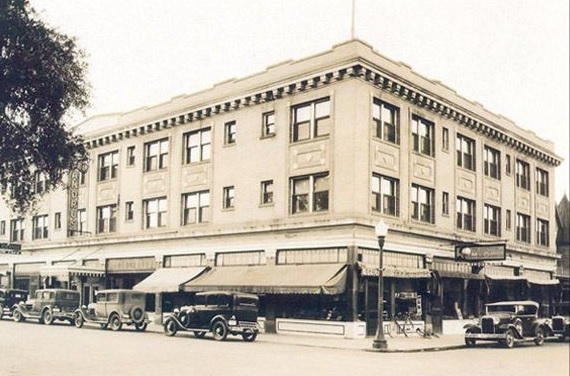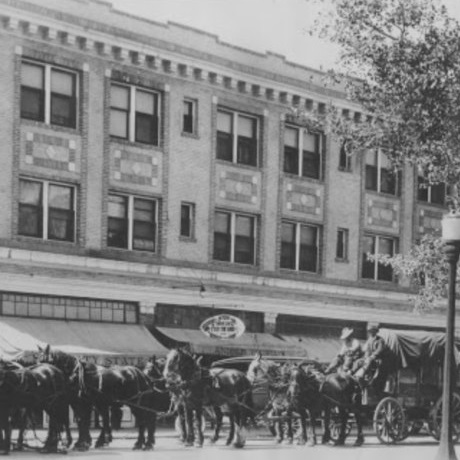Receive for Free - Discover & Explore eNewsletter monthly with advance notice of special offers, packages, and insider savings from 10% - 30% off Best Available Rates at selected hotels.
history
Discover The Andrus Hotel, which was originally constructed by a prominent Montana sheep rancher named Harry Andrus.
The Andrus Hotel, a member of Historic Hotels of America since 2021, dates back to 1917.
VIEW TIMELINEGile Mitchell Interview - Owner of The Andrus Fountain Bar from 1960 to 1964.
Learn more of the history of The Andrus Hotel and its historic bar, The Andrus Fountain Bar, via this fascinating oral account.
WATCH NOWListed on the U.S. National Register of Historic Places, The Andrus Hotel has stood as a cherished local landmark in downtown Dillon, Montana, for more than a century. Its history specifically dates back to a renowned sheep rancher named Harry Andrus, who lived just outside of Dillon during the early 1900s. For years, Andrus had watched as the city’s only hotel—the Hotel Metlen—reaped large profits from the passenger traffic generated by the Union Pacific Railroad. But Andrus had also observed that the years of service had greatly deteriorated the Hotel Metlen’s condition. As such, Andrus decided to develop his own hotel that would provide unheralded luxury to both the residents of Dillon, as well as the travelers who frequently visited via the railroad. In fact, he even wrote that: “I made my money in Beaverhead County and I want to build a hotel in Dillon; the best is none too good for Beaverhead County people.” Andrus immediately set about finding the best architect for the job and eventually hired Jesse Warren of Seattle. Together, the two men designed a magnificent three-story structure that utilized a brilliant blend of Renaissance Revival-style architecture. Construction lasted for several months, with Andrus sparing no expense. Indeed, the whole project had taken him $165,000 to finish.
His investment had clearly made a difference, too, for the new “Hotel Andrus” debuted as one of the most extravagant structures in all of Dillon. The building’s ground floor contained many great facilities, including a restaurant, bar, billiard parlor, and even a bank. Upstairs on the second floor awaited several spectacular guestrooms that Andrus and Warren had outfitted with the finest amenities, such as telephones, plush carpeting, and private bathrooms. The final floor had multiple apartments for long-term guests, as well as a few spacious showrooms for traveling salesmen. Perhaps the most outstanding feature Andrus and Warren created was the gorgeous lobby and its red marble staircase. The Hotel Andrus’s magnificence quickly made it a central fixture in Dillon, with even the local newspaper—the Dillon Tribune—declaring it as, “one of the finest, most modern and best-equipped hotels in the entire northwest.” Andrus himself managed the hotel right up until his death shortly before America’s entry into World War II. Now known as “The Andrus Hotel,’ this wonderful historic hotel continues to be one of the most sought after holiday destinations throughout Montana. Its current owner, Dr. John Micha, has since ensured that the legacy established by Harry Andrus will endure for generations to come. A member of Historic Hotels of America since 2021, this beautiful historic hotel is truly one of Montana’s most fascinating holiday destinations.
-
About the Location +
Nestled in the heart of the Beaverhead Valley, Dillon, Montana is a bucolic community steeped in history. It had actually formed thanks to the concerted efforts of Stanley Dillon, president of the now famous Union Pacific Railroad. Dillon had originally visited the region to survey potential routes for a spur of the Union Pacific known as the “Utah and Northern Railroad.” The project was a mammoth undertaking, as the potential railroad would traverse for miles through rugged terrain toward the city of Butte. Quickly realizing that few local communities could host any train depots, Dillon immediately set about founding a new series of towns that would cater to the prospective railway. Among the first settlements that Dillon helped create was the town of “Terminus” in 1880, which debuted near a series of prosperous gold mines just beyond the Beaverhead River. Dillon and the town’s first inhabitants specifically created a small interlocking street grid that was lined with many beautiful buildings. But Terminus soon began to expand exponentially shortly thereafter, as freight shipped along the railroad transformed the town into an important regional commercial center. In fact, most of the goods originated from the mines further north, giving Terminus another identity as a big mining town.
The robust financial activity attracted many more residents, as well as a few important cultural institutions. Perhaps the greatest civic facility to open at the time was the prestigious Montana Normal College in 1893. To honor the railroad for what it had done for Terminus, the residents even opted to rename it as “Dillon” after Stanley Dillon himself. While Dillon is no longer the same bustling railroad hub it was back in the 19th century, it has nonetheless retained its magnificent Gilded Age charm. Its unique rustic ambiance and fascinating past have since attracted countless cultural heritage travelers from across the United States. They have been particularly allured by the numerous historical landmarks surrounding the town, including Big Hole National Battlefield, the Old Montana Prison, and the Lewis & Clark Historic District. (Meriwether Lewis and William Clark led their legendary expedition through the region briefly in 1805.) Montana’s first two historic capitals—Bannack and Virginia City—are located nearby, as are several amazing outdoor destinations, like Red Rock’s Wildlife Refuge, Beaverhead Rock State Park, and Clare Canyon Reservoir.
-
About the Architecture +
When Harry Andrus decided to develop a brand-new hotel in his hometown of Dillon, Montana, he sought out the expertise of Seattle-based architect Jesse Warren. Together, the two men crafted a brilliant three-story building with some of the finest Renaissance Revival-style architecture seen in the area. Andrus had spared no expense, as the whole project had taken more than $165,000 to complete! The building’s ground floor contained many brilliant facilities, including a restaurant, bar, billiard parlor, and even a bank. Upstairs on the second floor awaited 30 spectacular guestrooms that Andrus and Warren had outfitted with the finest amenities, such as telephones, plush carpeting, and private bathrooms. The final floor contained multiple apartments for long-term guests, as well as spacious showrooms for traveling salesmen. Perhaps the most outstanding feature Andrus and Warren created inside the Hotel Andrus was the gorgeous lobby and its red marble staircase. Additional fixtures inside the lobby included decorative wood balustrade, stained-glass windows, and faux plaster classical columns. Guests could even expect the services of an elevator near the entrance, then the first of its kind to debut in all of Montana! The Andrus Hotel’s current owner, Dr. John Micha, has since striven to preserve the building’s original architectural features for future generations to appreciate.
Renaissance Revival itself architecture—sometimes referred to as "Neo-Renaissance”—is a group of architecture revival styles that date back to the 19th century. Neither Grecian nor Gothic in their appearance, Renaissance Revival-style architecture drew inspiration from a wide range of structural motifs found throughout Early Modern Western Europe. Architects in France and Italy were the first to embrace the artistic movement, believing that the revival of Renaissance architectural forms would reinvigorate their communities and inspire a renewed sense of civic pride. As such, those intellectuals incorporated the colonnades and low-pitched roofs of Renaissance-era buildings with the specific characteristics of Mannerist and Baroque-themed architecture. Perhaps the greatest structural component to a Renaissance Revival-style building involved the installation of a grand staircase similar to those located at both the Château de Blois and the Château de Chambord in France’s Loire Valley. This particular feature served as a central focal point for the design, often directing guests to a magnificent lobby or exterior courtyard. But the nebulous nature of Renaissance Revival architecture meant that its appearance varied widely across Europe. As such, historians today sometimes find it difficult to provide a specific definition for the architectural movement. Regardless, Renaissance Revival architecture today remains one of the world’s most enduring, appearing in countless places across the globe.




































